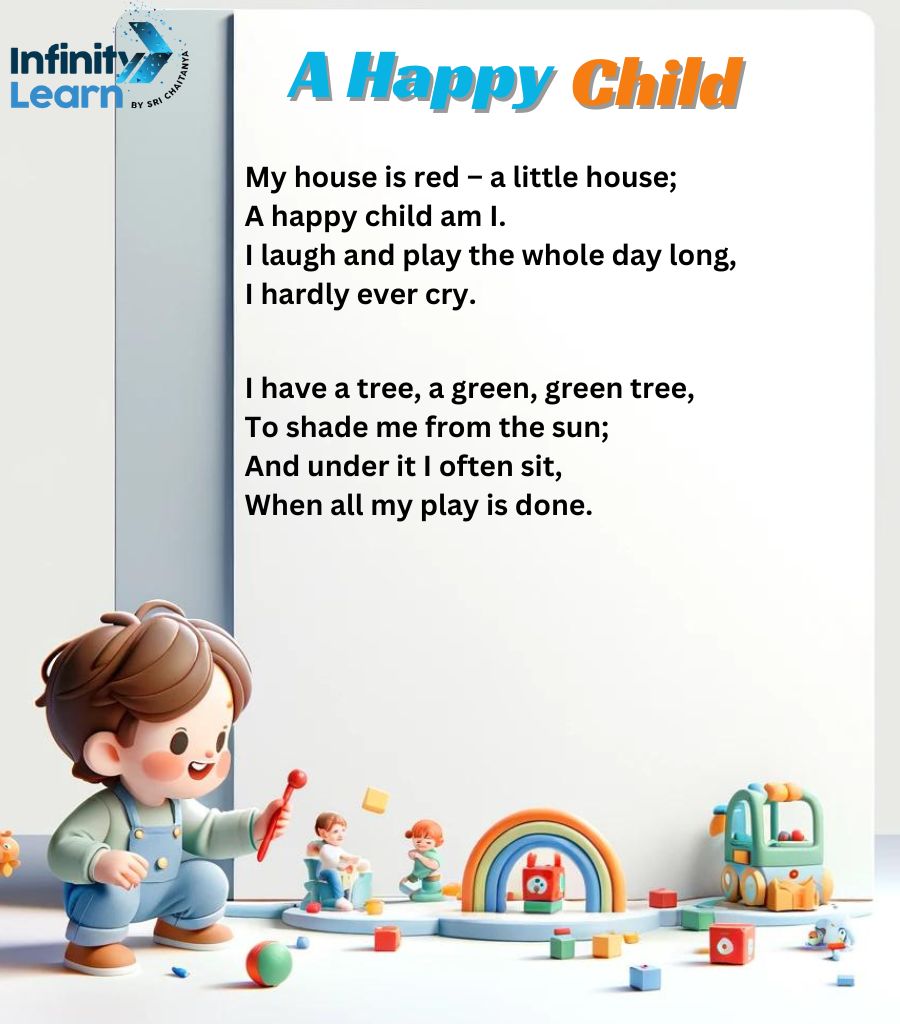Table of Contents
A Happy Child is a charming poem frequently featured in the English curriculum for first-grade students. Crafted by the esteemed poet Rabindranath Tagore, this piece beautifully encapsulates the purity and exuberance of childhood. It celebrates the carefree spirit and playful demeanor of children, striking a chord with young audiences through its straightforward yet profound depiction of happiness. With its vivid imagery and rhythmic verses, the poem captivates children’s attention, offering them an enjoyable experience while conveying valuable lessons about the wonders of childhood.
What is Happiness?
Feeling happy is like having a warm, fuzzy glow inside that makes you smile and feel great. It’s like when you’re hanging out with your friends, having so much fun that you don’t want it to stop. Or imagine how good it feels when you eat your favorite ice cream on a hot day—it’s so refreshing and tasty that it makes you happy all over!
Happiness can come from both big and small things. It might be a hug from someone you love, finding a pretty flower in the park, or hearing a funny joke that makes you laugh. Everyone finds happiness in different things, and that’s what makes it special. What makes you happy?
A Happy Child Poem
My house is red – a little house;
A happy child am I.
I laugh and play the whole day long,
I hardly ever cry.
I have a tree, a green, green tree,
To shade me from the sun;
And under it I often sit,
When all my play is done.
A Happy Child Poem Download PDF
Download the A Happy Child Poem Pdf format.

Summary of A Happy Child Poem for Class 1
A Happy Child poem by the famous Indian poet, Rabindranath Tagore. It’s all about a kid who is always cheerful and carefree, enjoying the little things in life. This child doesn’t worry about the past or future, but lives in the here and now, finding joy in nature and loved ones. The poem teaches us to live in the moment, cherish the small pleasures, and embrace the innocence of childhood. It’s a lovely reminder to appreciate life’s simple joys and stay present.
Themes of the Poem
The poem A Happy Child talks about how happy a child can be, the beauty of nature, and how life can be simple. The child in the poem feels happy and joyful, talking about things like a red house, laughter, and playing. The poem also shows how the child loves nature, especially a green tree that gives shade. Overall, the poem celebrates the happiness and innocence of childhood, and the beauty of nature. It reminds us to enjoy the simple things in life and to be present in the moment.
Activities to Do After A Happy Child Poem
Draw My Happiness: After reading the poem, ask the children to draw a picture of what makes them happy, similar to the child’s joy in the poem. It could be playing outside, spending time with family, or a favorite toy. This activity encourages self-expression and reflection on personal happiness.
Nature Walk: Organize a short nature walk around the school or a safe, green area nearby. Encourage the children to observe the sky, trees, and flowers, just like the child in the poem. They can collect leaves or flowers to create a nature collage back in the classroom.
Happy Words Collage: Provide magazines, newspapers, and colored papers. Ask the children to cut out words or pictures that represent happiness to them. They can then glue these onto a poster board to create a “Happy Words Collage,” promoting literacy and creativity.
Happiness Circle Time: Have a circle time where each child shares a small story or moment when they felt happy, similar to the feelings expressed in the poem. This activity fosters social skills and helps children listen to and learn from each other’s experiences.
Gratitude Jar: Create a classroom “Gratitude Jar.” Each day, children can write or draw something they’re thankful for on a slip of paper and add it to the jar. Once a week, share some of the slips during a class discussion, highlighting the theme of appreciation found in the poem.
Tips for Parents
- Ask Open-Ended Questions: Encourage children to think and express themselves by asking questions such as, “What makes you happy?” and “How do you feel when you are playing outside?”
- Talk About Nature: Discuss the importance of nature in our lives and how it can make us happy, similar to the child in the poem. Ask them about their favorite outdoor activities.
- Explore Feelings: Use the poem to talk about different feelings. Discuss how expressing and sharing our feelings with others can lead to happiness.
FAQs on A Happy Child Poem
What is the main theme of A Happy Child poem?
The main theme is the joy and contentment found in childhood, especially through appreciating nature and being present.
How can A Happy Child poem benefit children in Class 1?
It fosters a love for poetry, encourages appreciation for simple joys, and helps them express feelings and understand contentment.
Are there any activities that can be paired with A Happy Child poem?
Yes, activities include creating nature-inspired artwork, nature walks, and discussions on happiness, linking the poem's themes to personal experiences.









